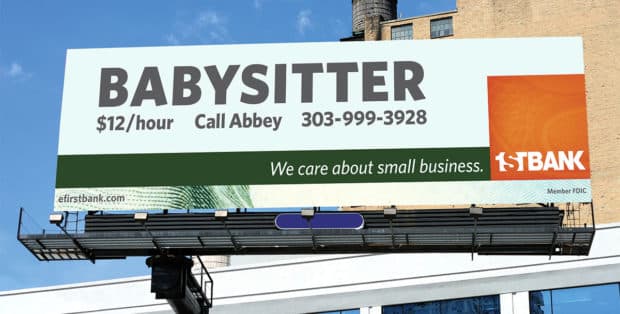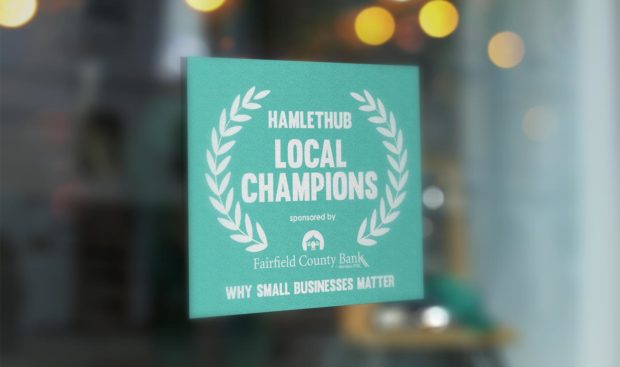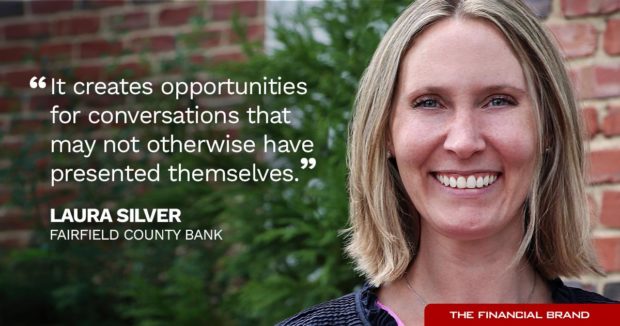Stacey Sussman started out as a part-time baker in the kitchen of her Ridgefield, Conn., home, before leaving a corporate marketing job to pursue her passion full-time in October 2020.
Fairfield County Bank was among the first places Sussman says she called when the sideline became a growing company, Stacey’s Totally Baked. Seeing the bank associated with a local effort to celebrate small businesses is a big part of what prompted her to reach out.
HamletHub, a digital publication in her hometown has a feature called “Why Small Businesses Matter,” which is a short, Q&A-style profile of a small-business owner. Fairfield County Bank is prominently noted as a sponsor on the profiles, and a new one appears every weekday.
The bank also gives each business that’s featured a “window cling” to display, in honor of the recognition.
“I’ve seen the signs up for years,” says Sussman, who ended up being profiled in June 2021 and received a window cling of her own from the bank afterward. “The next logical step, once I needed financing and needed insurance, was to reach back out to them because of what they do and how they help local businesses.”
Practically every community bank seeks to boost its local bona fides by sponsoring events and donating to charities in the markets where it operates. But the profiles on the HamletHub website gives Fairfield County Bank more of a direct entree to small businesses like Stacey’s Totally Baked, as the bank does outreach to all of those who are featured.
“It creates opportunities for conversations that may not otherwise have presented themselves,” says Laura Silver, marketing manager at the $1.9 billion-asset bank.

Unlocking Digital Acquisition: A Bank’s Journey to Become Digital-First
This webinar will offer a comprehensive roadmap for digital marketing success, from building foundational capabilities and structures and forging strategic partnerships, to assembling the right team.
Read More about Unlocking Digital Acquisition: A Bank’s Journey to Become Digital-First

Move the Needle from Attrition to Acquisition
Vericast’s 2024 Financial TrendWatch explores seven of today’s most critical financial services trends to provide a complete view of the current loyalty landscape.
Read More about Move the Needle from Attrition to Acquisition
Highlighting Small Businesses Is a Popular Marketing Strategy
Bank marketing often leans on stories about small businesses — though not quite in the same way as with Fairfield County Bank.
Main Street Bank in Marlborough, Mass., for example, is among the many that post video testimonials on its website and YouTube channel. “I’ve been doing business personally with Main Street Bank for 62 years,” says Jimmy Falconi, the owner of Falconi Energy, who offers a glowing review in one of the “Story in a Minute” videos the bank has shared. “I feel like the bank is sitting in that chair working with me on a day-to-day basis,” Falconi says.
Paid advertising campaigns, which can help promote the business as well as the bank, are another common tactic. In a memorable campaign more than a decade ago, FirstBank in Lakewood, Colo., gave this approach a fun twist. Instead of testimonials, it put up billboards plugging some very small businesses indeed — a babysitter, a piano teacher and a wedding singer. “Babysitter, $12/hour,” said one. “Call Abbey,” followed by a phone number. The bank’s logo appeared in the corner, along with the line, “We care about small business.”
 But the HamletHub initiative is not specific to Fairfield County Bank customers.
But the HamletHub initiative is not specific to Fairfield County Bank customers.
The bank does not decide which businesses are profiled, nor do participating businesses pay for the coverage, says Kerry Anne Ducey, founder and president of the online publisher behind “Why Small Businesses Matter.” The bank became a sponsor shortly after the feature launched in 2018.
The format is relatively simple. Participants answer three questions: why they started their businesses, what their most popular products or services are, and what other small businesses do they patronize in the community.
Sussman, for example, gave shoutouts to a florist, a graphic designer, and a retailer who provides espresso beans for her confectionary creations.
Why Storytelling? People Are More Interesting Than Products
One reason banks like to showcase small businesses in their advertising campaigns is that it can help make financial products more relatable, says Brian Kelley, a creative director at the advertising and marketing firm JPL in Harrisburg, Pa.
However, compared to other forms of advertising, stories can be slower to generate results, and banks need to be clear on how those results will be measured, Kelley says. For example, a community bank in Pennsylvania, which worked with JPL to feature stories about business customers in a series of print ads, compared activity during the campaign to a time period before the ads ran.
“It was seen as being very successful for them because it put a name to these products that they were selling,” Kelley says, noting that the bank reported record growth that quarter.
A storytelling approach also serves as a reflection of the bank’s values, presumably values that are shared by its potential customers. “That creates a connection,” says Therese Pramick, manager of content writing at JPL.
One of the values a bank might want to illustrate is “doing good in the community,” for example. So a case study could show how a business customer benefited the community thanks to bank financing, Pramick says.
While understanding the target audience is always important in marketing, it requires extra emphasis with storytelling tactics, the two marketers say.
Beyond the values of those being targeted, there’s the question of what media they pay attention to, whether it’s podcasts, YouTube, LinkedIn, Instagram or something else, Kelley says.
Credibility is also a factor, not just that of businesses being highlighted, but any outside media organizations a bank partners with, he adds.
Read More:
- How Banks Can Avoid Losing Small-Business Loans to Fintechs
- Ad Strategies from the Industry’s Most Creative Bank+Agency Partnership

Social Media as One Measure of Return on Investment
Thanks to the “Why Small Businesses Matter” sponsorship, Fairfield County Bank has seen an increase in its social media impact, as measured by media monitoring company Meltwater, Silver says.
Once a profile is published online, the bank, the digital publication and the featured business share it on Facebook, Instagram and other social media channels. According to Meltwater, the additional exposure is worth an estimated $235,000 in advertising, Silver says.
“The impact and results the ‘Why Small Businesses Matter’ program has produced far outweigh the expenditure,” she says, declining to share the cost.
Harder to measure but equally important, the sponsorship gives bank employees an opportunity to connect with small businesses in the community, Silver says.
The bank created a task force responsible for congratulating businesses that have been profiled and presenting them with the window cling, which has the bank’s name on it. Many are on display in storefront windows, giving the bank additional exposure.
Even owners of home-based businesses have posted photos of themselves with the clings on social media, says Kathy Graham, manager of the bank’s Ridgefield branch. A pet sitter, for example, photographed a dog holding the cling.
Fairfield County Bank’s task force members also connect on social media with the profiled businesses and invite the owners to educational sessions on topics such as taxes and cybersecurity that the bank hosts, Silver says.

Why Industry Cloud for Banking?
PwC’s Industry Cloud for Banking helps deliver personalized products and services that today’s customers expect.

Instant Messaging. Instant Impact.
Connect with your customers and provide lightning-fast support as effortlessly as texting friends. Two-way SMS text messaging is no longer optional.
Initiative Could Expand With Other Bank Sponsors
When customers began asking how they could be profiled, the bank worked with HamletHub to create an option for them: printed postcards with a QR code that takes business owners to a landing page where they can answer the three questions.
The goal is to give bank customers an opportunity to take part, not to sway decisions by HamletHub, Silver says. “There’s no favoritism.”
After starting in Ridgefield, the profile series has expanded to other Connecticut towns where Fairfield County Bank has branches, such as Bridgeport, Danbury and Norwalk.
Ducey also is hoping to pitch the idea to community banks elsewhere. She envisions HamletHub, which operates the Ridgefield site as well as another in Westchester, N.Y., as a network of hyperlocal news sites.
She sees this type of marketing as a way for banks to distinguish themselves from fintechs. “It’s really an incredible opportunity to have an intimate relationship, I’d say, with small businesses.”
Ducey says she and her staff vet businesses to be profiled to ensure they meet the goal of making positive contributions to the community. Her process includes reviewing the answers to the questions, verifying the company’s address, checking its online presence for professionalism, and reviewing its social media sites for freshness and negative comments.
Read More:
- Social Media Savvy Stokes Outsize Customer Engagement for This Bank
- The 68 Million Consumers Financial Institutions Are Overlooking

That’s a Fine How-Do-You-Do (Truly)
Silver appreciates that the sponsorship gives Fairfield County Bank employees the opportunity to get conversations going with small businesses, no sales pitch involved.
That’s one thing that made an impression on Sussman. Bank employees had ordered goodies from Stacey’s Totally Baked in its early days and Sussman recalls one of them suggesting she look into being profiled as a way to get some free advertising.
“They took an interest in me,” says Sussman, who now operates a storefront location and employs two people.









